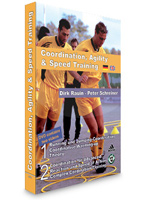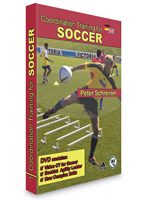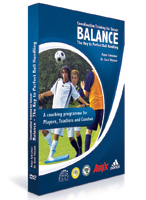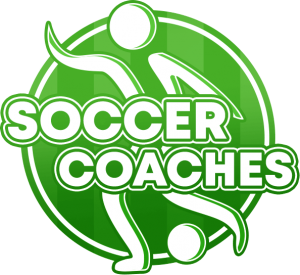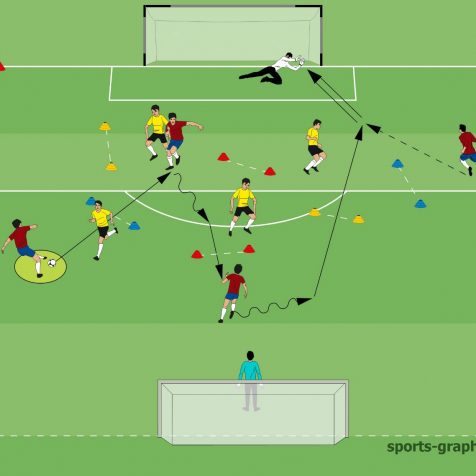Several muscles are needed to enable the body to perform soccer movements properly, quickly, powerfully and enduringly.
The muscles of soccer players should therefore be controlled by a finely tuned nervous system. The exact coordination of skeletal muscles and central nervous system is regulated and controlled by bodily processes that are covered by the term “coordination”. Coordination is, however, a multifaceted term.
In essence it relates to learning, controlling and using movements. Soccer players should be capable of learning new techniques quickly, economically and precisely, and adjusting them to take account of unexpected events.
Players who have been taught good coordination can control their movements when they have to act quickly, under pressure from an opponent, in tight situations.
Coordination Training with Coordination Ladder:
Coordination skills Before we deal with training for coordination skills we should take a close look at the following questions.
- Are there coordination skills that are needed for all types of sports and sporting tasks?
- Are reaction times in athletics and soccer and in reaction tests with electronic machines all dependent on one and the same skill?
- Is, for example, the ability to balance on a board that is supported by a ball of any relevance to the demands made on a soccer player’s sense of balance?
Experts have expressed justified doubts about whether there are skills that can be conditioned independently of a specific type of sport. The complex reactions of a soccer player depend on a host of perceptive elements and previous experience (anticipation). They certainly cannot be compared with the reaction to a simple signal such as a starter’s pistol. This is why coordination skills should not be worked on in isolation from the circumstances and demands of the type of sport.
Which coordination skills are important for a soccer player?
- Spatial orientation (i.e. a player’s awareness of his own position on the pitch in relation to teammates and opponents, even after turning).
- Kinesthetic differentiation (e.g. “feel” for the ball).
- Balance (e.g. stable posture even when under pressure from an opponent).
- Speed of reaction (e.g. to be able to be first to the ball when it rebounds from the goalkeeper)
- Rhythmic skills (e.g. an explosive start on landing after jumping to head the ball, or an elegant dribble after a feint).
More Information about Coordination Training
The following coordination skills are often mentioned in the literature:
- Motor adjustment
- Combinatory ability
- Sense of movement
- Suppleness
- Anticipation
- Motor memory.
How can all of these skills and components be taught and conditioned?
What are the consequences for training sessions with soccer players?
Movement coordination contains a high proportion of perception, anticipation and concentration. Soccer players should carry out general coordination drills as early as possible, so that they can learn to move their bodies precisely in a wide variety of ways. The more varied a soccer player’s childhood experience of movement, the better he can control his muscles with the help of his nervous system. Numerous drills I will show in article:
“General coordination training“. Coaches should always remember that coordination training is “not stereotyped, dull or distracting repetition of movements but is a motivated, concentrated and varied movement activity.”
As young soccer players become older and their skills improve, the proportion of soccer-specific coordination training should be increased. The typical demands that the game makes on the player should be at the heart of coordination conditioning. It is important that varied basic training with general coordination drills for soccer players should be followed by effective coordination training with soccer-specific movements (techniques) under varying conditions of difficulty. In concrete terms this means that the players should be asked to use techniques that they have already mastered while carrying out additional tasks under more difficult or changed conditions. The coach could place rods or tires in sequence and ask the players to run over them before or after using soccer techniques, or he could ask the players to perform drills within a certain time. This subject is dealt with in detail in the article on “Special coordination training for soccer players”. To summarize, coordination is a key skill for success in soccer and should therefore be given high priority in training sessions.
More information in the DVDs for Coordination Training:
Order these DVDs/Videos here:
Coordination Training with the Soccer Ball
Contents:
- Coordination with a soccer ball
- Coordination and warm-up
- Technique-oriented coordination training
- Coordination and agility ladder
- Reaction and speed training
- Coordination and shooting
Coordination and the nervous system
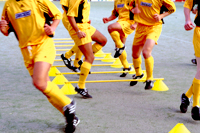
Soccer players should learn as early as possible to move their bodies precisely in a wide variety of ways. The more varied their childhood experience of movement, the better they can control their muscles with the help of the nervous system.
“Young players with good coordination can perform better at soccer than others who have the same or even slightly better conditional potential. Only soccer players with well developed coordination skills can translate their conditional capabilities optimally into corresponding performances.”
Running Coordination for Soccer Players 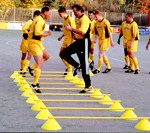
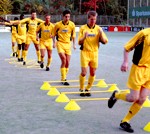 Modern soccer is characterized by its high tempo. To play soccer successfully, players must react faster than ever when they receive the ball, as well as making frequent sudden changes of direction, sprints into free space and instant switches from defense to attack. The demands on soccer players are so great that special and systematic training of their running coordination, especially their running technique and rhythm, appears essential.
Modern soccer is characterized by its high tempo. To play soccer successfully, players must react faster than ever when they receive the ball, as well as making frequent sudden changes of direction, sprints into free space and instant switches from defense to attack. The demands on soccer players are so great that special and systematic training of their running coordination, especially their running technique and rhythm, appears essential.
What are the special aspects of the conditioning of running coordination for soccer players?
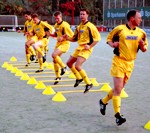
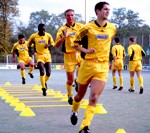 The running performance demanded of a soccer player differs considerably from that of an athlete. Sprints, turns, changes of direction, runs with the ball and challenges for the ball both before and after a sprint require the player to adjust his stride length and frequency to widely varied game situations. This makes a variable, flexible and selective application of running techniques during the game necessary. For selective conditioning of running coordination, it is necessary to set priorities within training sessions. Fast footwork, involving lightning fast coordination of nerves and foot muscles, is at the heart of many drills. Small, rapid steps ensure that the player can control the ball securely and move in any direction he chooses. The object is to remain in contact with the ground. He can then retain control of his body and accelerate quickly in any given direction. In addition, good footwork is essential to a good shooting technique.
The running performance demanded of a soccer player differs considerably from that of an athlete. Sprints, turns, changes of direction, runs with the ball and challenges for the ball both before and after a sprint require the player to adjust his stride length and frequency to widely varied game situations. This makes a variable, flexible and selective application of running techniques during the game necessary. For selective conditioning of running coordination, it is necessary to set priorities within training sessions. Fast footwork, involving lightning fast coordination of nerves and foot muscles, is at the heart of many drills. Small, rapid steps ensure that the player can control the ball securely and move in any direction he chooses. The object is to remain in contact with the ground. He can then retain control of his body and accelerate quickly in any given direction. In addition, good footwork is essential to a good shooting technique. 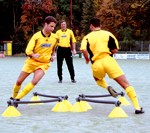
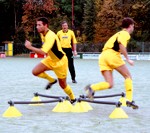 By continuously adjusting his distance from the ball, a player ensures that he is in the best position when he shoots. As a result of practicing changes in stride frequency and length in a variety of drills, a player is able to adjust his speed to the needs of the game situation. A long, powerful sprint down the wing requires a different technique to a subtle change of direction and a short sprint in a restricted space. Players should also be able to switch smoothly and quickly from the small strides appropriate to a challenge for the ball to the long strides needed to sprint away into space.
By continuously adjusting his distance from the ball, a player ensures that he is in the best position when he shoots. As a result of practicing changes in stride frequency and length in a variety of drills, a player is able to adjust his speed to the needs of the game situation. A long, powerful sprint down the wing requires a different technique to a subtle change of direction and a short sprint in a restricted space. Players should also be able to switch smoothly and quickly from the small strides appropriate to a challenge for the ball to the long strides needed to sprint away into space.
YouTube Channel: Playlist Coordination Training:
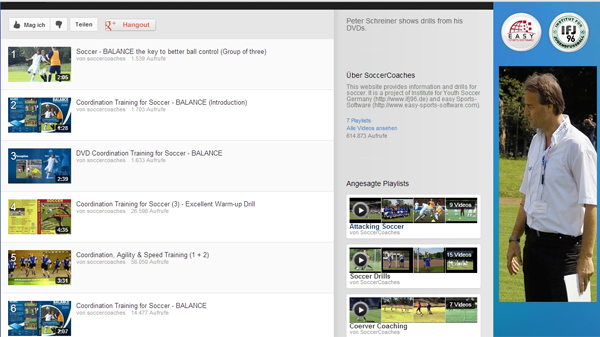
——————————————————————————————————
More information in the DVDs for Coordination Training:

